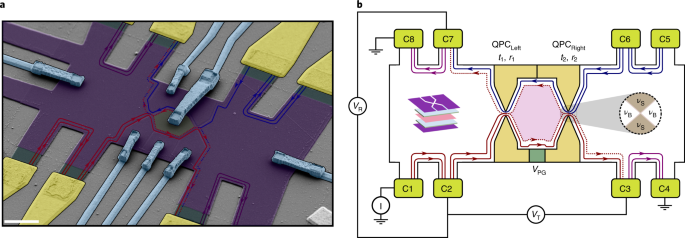
- Select a language for the TTS:
- UK English Female
- UK English Male
- US English Female
- US English Male
- Australian Female
- Australian Male
- Language selected: (auto detect) - EN
Play all audios:
ABSTRACT Interferometers probe the wave-nature and exchange statistics of indistinguishable particles—for example, electrons in the chiral one-dimensional edge channels of the quantum Hall
effect (QHE). Quantum point contacts can split and recombine these channels, enabling interference of charged particles. Such quantum Hall interferometers (QHIs) can unveil the exchange
statistics of anyonic quasi-particles in the fractional quantum Hall effect (FQHE). Here, we present a fabrication technique for QHIs in van der Waals (vdW) materials and realize a tunable,
graphene-based Fabry–Pérot (FP) QHI. The graphite-encapsulated architecture allows observation of FQHE at a magnetic field of 3T and precise partitioning of integer and fractional edge
modes. We measure pure Aharonov–Bohm interference in the integer QHE, a major technical challenge in small FP interferometers, and find that edge modes exhibit high-visibility interference
due to large velocities. Our results establish vdW heterostructures as a versatile alternative to GaAs-based interferometers for future experiments targeting anyonic quasi-particles. Access
through your institution Buy or subscribe This is a preview of subscription content, access via your institution ACCESS OPTIONS Access through your institution Access Nature and 54 other
Nature Portfolio journals Get Nature+, our best-value online-access subscription $29.99 / 30 days cancel any time Learn more Subscribe to this journal Receive 12 print issues and online
access $259.00 per year only $21.58 per issue Learn more Buy this article * Purchase on SpringerLink * Instant access to full article PDF Buy now Prices may be subject to local taxes which
are calculated during checkout ADDITIONAL ACCESS OPTIONS: * Log in * Learn about institutional subscriptions * Read our FAQs * Contact customer support SIMILAR CONTENT BEING VIEWED BY OTHERS
A TUNABLE FABRY–PÉROT QUANTUM HALL INTERFEROMETER IN GRAPHENE Article 25 February 2021 STRONGLY COUPLED EDGE STATES IN A GRAPHENE QUANTUM HALL INTERFEROMETER Article Open access 02 August
2024 EVIDENCE FOR CORRELATED ELECTRON PAIRS AND TRIPLETS IN QUANTUM HALL INTERFEROMETERS Article Open access 20 November 2024 DATA AVAILABILITY The data that support the findings of this
study are available at the online depository Zenodo: https://doi.org/10.5281/zenodo.4430703. Source data are provided with this paper. REFERENCES * Pérot, A. & Fabry, C. On the
application of interference phenomena to the solution of various problems of spectroscopy and metrology. _Astrophys. J._ 9, 87–155 (1899). Article Google Scholar * Bocquillon, E. et al.
Electron quantum optics in ballistic chiral conductors. _Ann. Phys. (Berl.)_ 526, 1–30 (2014). Article CAS Google Scholar * van Wees, B. J. et al. Observation of zero-dimensional states
in a one-dimensional electron interferometer. _Phys. Rev. Lett._ 62, 2523–2526 (1989). Article Google Scholar * Willett, R. L., Pfeiffer, L. N. & West, K. W. Measurement of filling
factor 5/2 quasiparticle interference with observation of charge e/4 and e/2 period oscillations. _Proc. Natl Acad. Sci. USA_ 106, 8853–8858 (2009). Article CAS Google Scholar * McClure,
D. T., Chang, W., Marcus, C. M., Pfeiffer, L. N. & West, K. W. Fabry–Perot interferometry with fractional charges. _Phys. Rev. Lett._ 108, 256804 (2012). Article CAS Google Scholar *
Willett, R. L., Nayak, C., Shtengel, K., Pfeiffer, L. N. & West, K. W. Magnetic-field-tuned Aharonov–Bohm oscillations and evidence for non-abelian anyons at _v_ = 5/2. _Phys. Rev.
Lett._ 111, 186401 (2013). Article CAS Google Scholar * Ofek, N. et al. Role of interactions in an electronic Fabry–Perot interferometer operating in the quantum Hall effect regime.
_Proc. Natl Acad. Sci. USA_ 107, 5276–5281 (2010). Article CAS Google Scholar * Ji, Y. et al. An electronic Mach–Zehnder interferometer. _Nature_ 422, 415–418 (2003). Article CAS Google
Scholar * Camino, F. E., Zhou, W. & Goldman, V. J. Realization of a Laughlin quasiparticle interferometer: observation of fractional statistics. _Phys. Rev. B_ 72, 075342 (2005). * de
C. Chamon, C., Freed, D. E., Kivelson, S. A., Sondhi, S. L. & Wen, X. G. Two point-contact interferometer for quantum Hall systems. _Phys. Rev. B_ 55, 2331–2343 (1997). Article Google
Scholar * Nayak, C., Simon, S. H., Stern, A., Freedman, M. & Das Sarma, S. Non-abelian anyons and topological quantum computation. _Rev. Mod. Phys._ 80, 1083–1159 (2008). Article CAS
Google Scholar * Zhang, Y. et al. Distinct signatures for coulomb blockade and Aharonov–Bohm interference in electronic Fabry–Perot interferometers. _Phys. Rev. B_ 79, 241304 (2009).
Article Google Scholar * Halperin, B. I., Stern, A., Neder, I. & Rosenow, B. Theory of the Fabry–Pérot quantum Hall interferometer. _Phys. Rev. B_ 83, 155440 (2011). Article Google
Scholar * Sivan, I. et al. Observation of interaction-induced modulations of a quantum Hall liquid’s area. _Nat. Commun._ 7, 12184 (2016). Article CAS Google Scholar * Röösli, M. P. et
al. Observation of quantum Hall interferometer phase jumps due to a change in the number of bulk quasiparticles. _Phys. Rev. B_ 101, 125302 (2020). Article Google Scholar * Nakamura, J. et
al. Aharonov–Bohm interference of fractional quantum Hall edge modes. _Nat. Phys._ 15, 563–569 (2019). Article CAS Google Scholar * Nakamura, J., Liang, S., Gardner, G. C. & Manfra,
M. J. Direct observation of anyonic braiding statistics. _Nat. Phys._ 16, 931–936 (2020). Article CAS Google Scholar * Bartolomei, H. et al. Fractional statistics in anyon collisions.
_Science_ 368, 173–177 (2020). Article CAS Google Scholar * Zibrov, A. A. et al. Even-denominator fractional quantum Hall states at an isospin transition in monolayer graphene. _Nat.
Phys._ 14, 930–935 (2018). Article CAS Google Scholar * Kim, Y. et al. Even denominator fractional quantum Hall states in higher Landau levels of graphene. _Nat. Phys._ 15, 154–158
(2019). Article CAS Google Scholar * Li, J. et al. A valley valve and electron beam splitter. _Science_ 362, 1149–1152 (2018). Article CAS Google Scholar * Young, A. F. & Kim, P.
Quantum interference and Klein tunnelling in graphene heterojunctions. _Nat. Phys._ 5, 222–226 (2009). Article CAS Google Scholar * Rickhaus, P. et al. Ballistic interferences in
suspended graphene. _Nat. Commun._ 4, 2342 (2013). Article Google Scholar * Ahmad, N. F. et al. Fabry–Pérot resonances and a crossover to the quantum Hall regime in ballistic graphene
quantum point contacts. _Sci. Rep._ 9, 3031 (2019). Article Google Scholar * Veyrat, L. et al. Low-magnetic-field regime of a gate-defined constriction in high-mobility graphene. _Nano
Lett._ 19, 635–642 (2019). Article Google Scholar * Zhang, G.-Q. et al. Coulomb-dominated oscillations in a graphene quantum Hall Fabry–Pérot interferometer. _Chin. Phys. B_ 28, 127203
(2019). Article CAS Google Scholar * Morikawa, S. et al. Edge-channel interferometer at the graphene quantum Hall pn junction. _Appl. Phys. Lett._ 106, 183101 (2015). Article Google
Scholar * Wei, D. S. et al. Mach–Zehnder interferometry using spin- and valley-polarized quantum Hall edge states in graphene. _Sci. Adv_. 3, e1700600 (2017). * Marguerite, A. et al.
Imaging work and dissipation in the quantum Hall state in graphene. _Nature_ 575, 628–633 (2019). Article CAS Google Scholar * Chklovskii, D. B., Shklovskii, B. I. & Glazman, L. I.
Electrostatics of edge channels. _Phys. Rev. B_ 46, 4026–4034 (1992). Article CAS Google Scholar * Nakaharai, S., Williams, J. R. & Marcus, C. M. Gate-defined graphene quantum point
contact in the quantum Hall regime. _Phys. Rev. Lett._ 107, 036602 (2011). Article CAS Google Scholar * Zimmermann, K. et al. Tunable transmission of quantum Hall edge channels with full
degeneracy lifting in split-gated graphene devices. _Nat. Commun._ 8, 14983 (2017). Article CAS Google Scholar * Baer, S. et al. Interplay of fractional quantum Hall states and
localization in quantum point contacts. _Phys. Rev. B_ 89, 085424 (2014). Article Google Scholar * Neder, I., Heiblum, M., Levinson, Y., Mahalu, D. & Umansky, V. Unexpected behavior in
a two-path electron interferometer. _Phys. Rev. Lett._ 96, 016804 (2006). Article CAS Google Scholar * McClure, D. T. et al. Edge-state velocity and coherence in a quantum Hall
Fabry–Pérot interferometer. _Phys. Rev. Lett._ 103, 206806 (2009). Article CAS Google Scholar * Déprez, C. et al. A tunable Fabry–Pérot quantum Hall interferometer in graphene. _Nat.
Nanotechnol._ https://doi.org/10.1038/s41565-021-00847-x (2020). * Zibrov, A. A. et al. Tunable interacting composite fermion phases in a half-filled bilayer-graphene Landau level. _Nature_
549, 360–364 (2017). Article CAS Google Scholar * Li, J. I. A. et al. Even-denominator fractional quantum Hall states in bilayer graphene. _Science_ 358, 648–652 (2017). Article CAS
Google Scholar * Shi, Q. et al. Odd- and even-denominator fractional quantum Hall states in monolayer WSe2. _Nat. Nanotechnol._ 15, 569–573 (2020). Article CAS Google Scholar * Amet, F.
et al. Supercurrent in the quantum Hall regime. _Science_ 352, 966–969 (2016). Article CAS Google Scholar * Lee, G.-H. et al. Inducing superconducting correlation in quantum Hall edge
states. _Nat. Phys._ 13, 693–698 (2017). Article CAS Google Scholar * Zhao, L. et al. Interference of chiral Andreev edge states. _Nat. Phys._ 16, 862–867 (2020). Article CAS Google
Scholar * Huang, X.-L. & Nazarov, Y. V. Interaction-induced supercurrent in quantum Hall setups. _Phys. Rev. B_ 100, 155411 (2019). Article CAS Google Scholar * Clarke, D. J.,
Alicea, J. & Shtengel, K. Exotic non-Abelian anyons from conventional fractional quantum Hall states. _Nat. Commun._ 4, 1348 (2013). Article Google Scholar * Mong, R. S. K. et al.
Universal topological quantum computation from a superconductor-abelian quantum Hall heterostructure. _Phys. Rev. X_ 4, 011036 (2014). Google Scholar * Purdie, D. G. et al. Cleaning
interfaces in layered materials heterostructures. _Nat. Commun._ 9, 5387 (2018). Article CAS Google Scholar * Wang, L. et al. One-dimensional electrical contact to a two-dimensional
material. _Science_ 342, 614–617 (2013). Article CAS Google Scholar * Ronen, Y. Aharonov–Bohm effect in graphene-based Fabry–Pérot quantum Hall interferometers. zenodo
https://doi.org/10.5281/zenodo.4430703 (2021). Download references ACKNOWLEDGEMENTS We thank B. I. Halperin, M. Heiblum, E. Zeldov, H. Shapourian and D. S. Wei for helpful discussions. P.K.,
Y.R., T.W. and L.E.A. acknowledge support from DOE (no. DE-SC0012260) in regard to measurement, characterization and analysis. P.K., D.H.N., and Y.J.S. acknowledge support from DOE (no.
DE-SC0019300) for sample preparation and characterization. K.W. and T.T. acknowledge support from the Elemental Strategy Initiative conducted by the MEXT, Japan, (grant no. JPMXP0112101001),
JSPS KAKENHI (grant no. JP20H00354) and CREST (no. JPMJCR15F3, JST). S.Y.L. and Y.H.L. acknowledge support from the Institute for Basic Science (no. IBS-R011-D1). T.W. and A.T.P. were
supported by the Department of Defense through the National Defense Science & Engineering Graduate Fellowship Program. Nanofabrication was performed at the Center for Nanoscale Systems
at Harvard, supported in part by an NSF NNIN award (no. ECS-00335765). This research used resources of the Center for Functional Nanomaterials, which is a US DOE Office of Science Facility,
at Brookhaven National Laboratory under contract no. DE-SC0012704. AUTHOR INFORMATION Author notes * These authors contributed equally: Yuval Ronen, Thomas Werkmeister. AUTHORS AND
AFFILIATIONS * Department of Physics, Harvard University, Cambridge, MA, USA Yuval Ronen, Danial Haie Najafabadi, Andrew T. Pierce, Laurel E. Anderson, Bobae Johnson, Amir Yacoby &
Philip Kim * John A. Paulson School of Engineering and Applied Sciences, Harvard University, Cambridge, MA, USA Thomas Werkmeister, Amir Yacoby & Philip Kim * Center for Functional
Nanomaterials, Brookhaven National Laboratory, Upton, NY, USA Young Jae Shin * Center for Integrated Nanostructure Physics, Institute for Basic Science, Suwon, Republic of Korea Si Young Lee
& Young Hee Lee * Research Center for Functional Materials, National Institute for Materials Science, Tsukuba, Japan Kenji Watanabe * International Center for Materials
Nanoarchitectonics, National Institute for Materials Science, Tsukuba, Japan Takashi Taniguchi Authors * Yuval Ronen View author publications You can also search for this author inPubMed
Google Scholar * Thomas Werkmeister View author publications You can also search for this author inPubMed Google Scholar * Danial Haie Najafabadi View author publications You can also search
for this author inPubMed Google Scholar * Andrew T. Pierce View author publications You can also search for this author inPubMed Google Scholar * Laurel E. Anderson View author publications
You can also search for this author inPubMed Google Scholar * Young Jae Shin View author publications You can also search for this author inPubMed Google Scholar * Si Young Lee View author
publications You can also search for this author inPubMed Google Scholar * Young Hee Lee View author publications You can also search for this author inPubMed Google Scholar * Bobae Johnson
View author publications You can also search for this author inPubMed Google Scholar * Kenji Watanabe View author publications You can also search for this author inPubMed Google Scholar *
Takashi Taniguchi View author publications You can also search for this author inPubMed Google Scholar * Amir Yacoby View author publications You can also search for this author inPubMed
Google Scholar * Philip Kim View author publications You can also search for this author inPubMed Google Scholar CONTRIBUTIONS Y.R., T.W. and P.K. conceived the idea and designed the
project. P.K. supervised the project. Y.R., T.W. and D.H.N. fabricated the devices. L.E.A., Y.J.S., B.J., S.Y.L., Y.H.L. and A.Y. helped and consulted at different stages of the fabrication
process and analysis. K.W. and T.T. provided the hBN crystals. Y.R., T.W. and A.T.P. performed the measurements. Y.R., T.W., A.Y. and P.K. wrote the paper with input from all authors.
CORRESPONDING AUTHOR Correspondence to Philip Kim. ETHICS DECLARATIONS COMPETING INTERESTS The authors declare no competing interests. ADDITIONAL INFORMATION PEER REVIEW INFORMATION _Nature
Nanotechnology_ thanks Gwendal Fève and the other, anonymous, reviewer(s) for their contribution to the peer review of this work. PUBLISHER’S NOTE Springer Nature remains neutral with regard
to jurisdictional claims in published maps and institutional affiliations. SUPPLEMENTARY INFORMATION SUPPLEMENTARY INFORMATION Supplementary Sections 1–6 and figures. SOURCE DATA SOURCE
DATA FIG. 2 Contains bare data for images. SOURCE DATA FIG. 3 Contains bare data for images. SOURCE DATA FIG. 4 Contains bare data for images. SOURCE DATA FIG. 5 Contains bare data for
images. SOURCE DATA FIG. 6 Contains bare data for images. RIGHTS AND PERMISSIONS Reprints and permissions ABOUT THIS ARTICLE CITE THIS ARTICLE Ronen, Y., Werkmeister, T., Haie Najafabadi, D.
_et al._ Aharonov–Bohm effect in graphene-based Fabry–Pérot quantum Hall interferometers. _Nat. Nanotechnol._ 16, 563–569 (2021). https://doi.org/10.1038/s41565-021-00861-z Download
citation * Received: 27 August 2020 * Accepted: 22 January 2021 * Published: 25 February 2021 * Issue Date: May 2021 * DOI: https://doi.org/10.1038/s41565-021-00861-z SHARE THIS ARTICLE
Anyone you share the following link with will be able to read this content: Get shareable link Sorry, a shareable link is not currently available for this article. Copy to clipboard Provided
by the Springer Nature SharedIt content-sharing initiative








